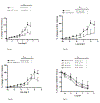Placental growth factor blunts uterine artery responses to angiotensin II
- PMID: 30771259
- PMCID: PMC7004274
- DOI: 10.1111/1471-0528.15656
Placental growth factor blunts uterine artery responses to angiotensin II
Abstract
Objective: Changes in maternal serum concentration of placental growth factor (PlGF) and vascular response to intravascular infusion of Angiotensin II (Ang II) follow a bell-shaped curve pattern during gestation. This study evaluates the effects of PlGF and soluble vascular endothelial growth factor receptor-1 (sFlt-1) on responses of human uterine arteries (UA) to Ang II.
Design: Experimental.
Setting: Baylor College of Medicine and Texas Children's Hospital-Pavilion for Women.
Sample: Uterine arteries samples (n = 14) were obtained from normotensive women undergoing caesarean hysterectomy at ≥32 weeks.
Methods: Uterine arteries rings were incubated with (1) Krebs solution; (2) PlGF at 1.45, 14.5, and 500 pg/ml; (3) sFlt-1 at 2 ng/ml; and (4) a combination of sFlt-1, and PlGF. Dose-contraction responses to Ang II were determined in UA rings incubated in the above-mentioned conditions. Responses were also measured in presence of L-NAME or inhibitors of endothelium-derived hyperpolarising factor: apamine and charybdotoxin. The t-test was used for comparisons.
Main outcome measure: Changes in vascular reactivity of UA rings.
Results: PlGF blunted (P = 0.03) and sFlt-1 increased (P <0.01) the UA maximum responses to Ang II. A combination of sFlt-1 and PlGF blunted UA responses to Ang II (P < 0.05). l-NAME, apamine, and charybdotoxin reversed the relaxation effects of PlGF on UA responses to Ang II (P < 0.05).
Conclusions: PlGF contributes to the blunted vascular response to Angiotensin II during normotensive pregnancies and sFlt-1 appears to attenuate this effect. PlGF and sFlt-1 may contribute to the regulation of vascular tone during pregnancy by altering the vascular response to Angiotensin II.
Funding: Baylor College of Medicine.
Tweetable abstract: Placental growth factor and soluble vascular endothelial growth factor receptor-1 modulate the uterine artery response to Angiotensin II in normotensive pregnant women.
Keywords: Angiotensin II; placental growth factor; response; sFlt-1; vascular.
© 2019 Royal College of Obstetricians and Gynaecologists.
Conflict of interest statement
Disclosure of Interests
We confirm that all authors including JE, AB, MB, AS, KF and CY declared no conflicts of interests with this manuscript.
Figures




Similar articles
-
Restoring placental growth factor-soluble fms-like tyrosine kinase-1 balance reverses vascular hyper-reactivity and hypertension in pregnancy.Am J Physiol Regul Integr Comp Physiol. 2016 Sep 1;311(3):R505-21. doi: 10.1152/ajpregu.00137.2016. Epub 2016 Jun 8. Am J Physiol Regul Integr Comp Physiol. 2016. PMID: 27280428 Free PMC article.
-
Evaluation of agreement of placental growth factor (PlGF) tests and the soluble FMS-like tyrosine kinase 1 (sFlt-1)/PlGF ratio, comparison of predictive accuracy for pre-eclampsia, and relation to uterine artery Doppler and response to aspirin.J Matern Fetal Neonatal Med. 2019 Jan;32(2):179-187. doi: 10.1080/14767058.2017.1373760. Epub 2017 Sep 11. J Matern Fetal Neonatal Med. 2019. PMID: 28851242 Clinical Trial.
-
Relationships of serum placental growth factor and soluble fms-like tyrosine kinase-1 with fetal and uterine artery Doppler indices in pre-eclampsia.Int J Gynaecol Obstet. 2019 May;145(2):176-181. doi: 10.1002/ijgo.12796. Epub 2019 Mar 13. Int J Gynaecol Obstet. 2019. PMID: 30801711
-
The role of disordered angiogenesis tissue markers (sflt-1, Plgf) in present day diagnosis of preeclampsia.Ginekol Pol. 2019;90(3):173-176. doi: 10.5603/GP.2019.0030. Ginekol Pol. 2019. PMID: 30950008 Review.
-
[Application of the concetrations ratio of soluble receptor tyrosine kinase type 1, and placental growth factor for short-term prediction and diagnosis of preeclampsia].Ceska Gynekol. 2016 Summer;81(4):272-278. Ceska Gynekol. 2016. PMID: 27882748 Review. Czech.
Cited by
-
Physiological and pathological roles of Ang II and Ang- (1-7) in the female reproductive system.Front Endocrinol (Lausanne). 2022 Dec 23;13:1080285. doi: 10.3389/fendo.2022.1080285. eCollection 2022. Front Endocrinol (Lausanne). 2022. PMID: 36619582 Free PMC article. Review.
-
Uteroplacental Circulation in Normal Pregnancy and Preeclampsia: Functional Adaptation and Maladaptation.Int J Mol Sci. 2021 Aug 11;22(16):8622. doi: 10.3390/ijms22168622. Int J Mol Sci. 2021. PMID: 34445328 Free PMC article. Review.
-
Calcitonin Gene Related Peptide, Adrenomedullin, and Adrenomedullin 2 Function in Uterine Artery During Human Pregnancy.Endocrinology. 2022 Jan 1;163(1):bqab204. doi: 10.1210/endocr/bqab204. Endocrinology. 2022. PMID: 34558598 Free PMC article.
-
PlGF Immunological Impact during Pregnancy.Int J Mol Sci. 2020 Nov 18;21(22):8714. doi: 10.3390/ijms21228714. Int J Mol Sci. 2020. PMID: 33218096 Free PMC article. Review.
-
O-GlcNAc impairs endothelial function in uterine arteries from virgin but not pregnant rats: The role of GSK3β.Eur J Pharmacol. 2020 Aug 5;880:173133. doi: 10.1016/j.ejphar.2020.173133. Epub 2020 Apr 25. Eur J Pharmacol. 2020. PMID: 32343970 Free PMC article.
References
-
- Levine RJ, Maynard SE, Qian C, Lim KH, England LJ, Yu KF et al. Circulating angiogenic factors and the risk of preeclampsia. N.Engl.J Med 2004;350:672–83. - PubMed
MeSH terms
Substances
Grants and funding
LinkOut - more resources
Full Text Sources
Miscellaneous

